VAM The Good The Bad & The Ugly...
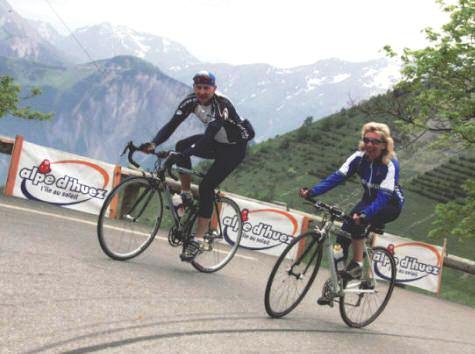
Climbing Alpe D'Heuz with your wife.
Does it get any better...?
The Bad & The Ugly?
Michele Ferrari, depending on who you talk to (and in what context), is
either a sinner or a saint. He has without doubt left as many
brilliant landmark
achievements in the world of cycling as he has dodgy.
He's as misunderstood by the public and governing bodies as he's adored by the elite riders of world cycling. In my opinion, for what it's worth, he's a flawed genius. But then the line between genius and lunatic can sometimes be blurred beyond distinction, as I keep telling the wife.
One of the better things Ferrari is responsible for, is the concept of VAM, which we will discuss here...

Power to Weight Ratio
The magic number I look for when riders visit for a
wVO2max test
is 4.0w kg for vets and 4.5w/kg for seniors.
We are all dedicated amateurs, training to the best of our ability, fitting the sport we love, around our family time and life in general. If you can hit four watts per kilo at your wVO2max threshold, you're doing okay.
Ferrari has calculated that anyone with aspirations of winning the Tour de France would be required to knock out 6.7w kg at lactate threshold.
Armstrong, during the early season events would weigh in at around 76 kilos and knock out 450 watts. As the tour approached this would be honed, with an obsessive precision, to reach 497 watts at 74 kilos.
We now know why and how, but that doesn't concern us here!
Your aim as a cyclist, without becoming obsessive, should be to maximise your power to weight ratio in the healthiest, legal and most time efficient manner you can.
Power or Weight?
So the answer is relatively simple. The formulae tell us that
if we lose weight or gain power we'll be a better rider. If we
lose weight and gain power we'll be a winner. If only the practical was
as simple as the theory.
The smoke and mirrors comes with the ability to combine the two factors in the right balance. There's no point in weighing 75 kilos and knocking out 300 watts at threshold if you drop to 70 kilos and can only produce 265 watts.
You've dropped from the magic 4.00 w/kg to 3.78. Not bad, but not good either, because you're now "less" of a rider in more ways than one.
If you drop to 72 kilos and can produce 290 watts, then that's where the gains can be made. We now have 4.02w/kg. See now it's beginning to make sense.
Losing weight ain't the be all and end all. You have to maintain the power you've worked hard to sustain. Also, you have to lose body fat, not muscle mass. And that opens a whole other can of worms we won't go in to now.
If you can drop to 70 kilos and maintain 300 watts, you're now in to 4.28w kg and will notice a serious difference in your ability to climb. For every kilo lost, while maintaining the same power output at threshold, it's possible to cut 1.25% from your climbing times.
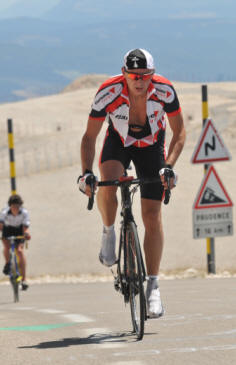
As you can see above, I climbed Alpe D'huez (to the proper Tour de France finish, not the water trough before the bridge) in 58 minutes, and two seconds but I always forget them, weighing 72 kilos.
If I'd have been a kilo lighter I would have knocked 43 seconds off my time.
I can get down to 69 kilos at the height of the season.
If I'd have been 69 kilos when climbing the Alpe, I could have sliced a massive two minutes off my time. Providing I could have maintained my power output.
This is useful information for all you sportive riders out there when tackling the big mountains.
Pantani holds
the record for the Alpe at 37 minutes 35 seconds; at the end of a
monster stage climbing at an unbelievable 24 kph. I reckon if I could get down to
around 30 kilos I could probably get close!
But then again...,
everything in moderation.
In Italian, (Ferrari's mother tongue) VAM is short for velocita ascensionale media; in English it's average climbing speed. Whatever you call it, it has a multitude of uses and the pro's, but more importantly their managers and technical strategists, use it during training and races to determine tactics, attacking strategies and more importantly, "do we chase?"
VAM, a tool designed and perfected by Michele Ferrari, is a number based comparator that's determined from the climbing speed on gradients of around 8%. It can be extrapolated up or down but it's accuracy is greater on consistent, longish, climbs.
When I say climbing speed for VAM I don't mean in kilometres an hour; as above when I said Pantani climbed at 24kph.
VAM is measured in "upward" metres an hour. So, say you have a VAM of 1500, trust me you don't but imagine you did, this means you can climb a vertical altitude or difference of 1,500 metres in an hour.
Alpe D'Huez's finish is at 1860 metres and the climb itself is 13.8 km long with an average gradient of 7.9%. The "climb" or altitude difference is 1090 metres.
My VAM for the Alpe was: (1090 metres x 60)/58 = 11271090 metres ascended, multiplied by 60 minutes, then divided by the minutes it took me to climb it.
However, there are other factors to be considered, which I'll cover later.
VAM & You
Ferrari calculates that an approximation of VAM can be
deduced from a rider's threshold power to weight ratio.
Again, I apologize for a reference to me but for confidentiality reasons, I'm the only one with the stats I can measure and publish.
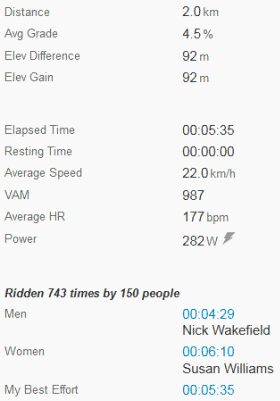
As mentioned earlier, when I'm on form and at 69 kilos, I can put
out 4.6w/kg. Above, is our "wVO2max test hill" in Jersey,
Rozel Climb.
Here are the Strava stats for a recent climbing session. It's
always our last climb of the day, so we're a little fatigued but it
gives us a good indicator of our fitness.
As you can see, my VAM was 987 m/h. Power was 282 watts, weight was 74 kilos. Which gives 3.8 w/kg.
Ferrari, reckons that you can multiply the threshold power to weight ratio by 300 and get a pretty good approximation of a riders VAM.
For this ride, that's 74 kilos (+10 kgs for winter bike and stuff), divided into 282 watts; which gives 3.57 watts per kilo.
Multiply 3.57 by 300, and you have a predicted VAM of 1071 m/h. With the actual VAM being 987 m/h, you can see it's close enough for our purposes. I must of had a head wind!
VAM & The (Enhanced) Pro's
To win a mountain stage of a Grand Tour it's predicted (by Ferrari) that a rider
needs a VAM of between 1650 and 1800m/h.
Pantani, when climbing Alpe D'Huez in 37 minutes produced a VAM of 1744, a remarkable number at the end of a huge Tour stage, but not wholly beyond the bounds of credibility.
Santiago Perez however, did stretch the realms of belief when he climbed the last 6.5K, and 560m of elevation, of the Puerto (clock that name) de Navacerrada in the 2004 Vuelta.
Burning the less-than-clean Roberto Heras off in the process, he stormed up the mountain with a VAM of 2067 m/h. That's right two thousand and sixty seven! This was on the 25th September.
Previously, on the 22nd of September, Perez climbed the final 12 kilometre ascent to Covatillia at a VAM of 1717; with the last headwinded, 8k averaging 8%, being climbed in 21:30 with a VAM of 1800.
So these results were as impressive as they were near the far reaches of what may have been possible. Three days later Perez achieved the impossible. Now, after his subsequent disqualification, we know why and how.
In 2000, Pantani attacked Armstrong on Stage 16 of the Tour, to Morzine. What to do, what to do? Chase, burn energy by holding the gap, leave him out to fry or say goodbye to the stage?
Urban myth has it that Johan Bruyneel phoned Ferrari from the team car.
Ferrari, (according to the myth) walking in the woods at the time, was passed all of the info by Bruyneel, a quick mental calculation and the instruction to "let him hang" came back.
The "Postals" sat up, kept their powder dry and Pantani cracked and came back to them. On the figures they had, his VAM (even chemically enhanced) was unsustainable.
That's what Armstrong insists (insisted) he was paying for; insight, advice and training plans. Now, we know better...
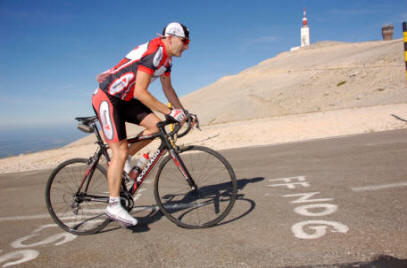
VAM & Landis
Now we come to another scandal. Floyd Landis' epic Stage 17 ride from the 2006 Tour.
Was it
testosterone fuelled or do the numbers stack up. Well it's not for
me to judge (others have since admitted/done that), but here are the stats.
For the 5 hour 23 minute stage, Landis averaged a solo inspired 281 watts. In April 2006 I "competed" in the Danguillaume Sportive. I took 5 hours 24 minutes and, if you remember, I blew my nuts off with 20 miles to go. But I still managed to average 195 watts. So 281 watts for a pro is, to be honest, quite believable. Especially when Jens Voigt, whom we never doubt, clocked up over 300 watts for his Stage 3 breakaway (with companions) in the same Tour.
As a reference, the 2006 Tour mountain stages were run off at an average 269 watts while the 2005 Tour saw 274 average mountain watts. If you've ever struggled to get just 10 watts added to your climbing power, you'll know how hard this is!
Back to Stage 17.
Landis scaled five climbs that day. Knowing how hard to climb is a skill worth having. I don't have that skill but I do have my SRM power meter. So I know how hard I can go on the climbs in Jersey, Europe and beyond.
If it's a short, sharp, one minute climb, I can hold 450 watts. For two minute climbs ~ it's 375w, for three ~ 350w, four ~ 300w, and for five minute, our longest climbs ~ 285w. It really is that clinical.
Jersey being a small island, has most climbs starting at sea level and finishing up around a max of 100 metres high.
Landis and his power guru, Dr Allen Lim, know that they needed to produce over 390 watts on the day's climbs, at altitude, to put time in to the field. 380 watts would hold them off and 370w would see the field clawing back the gap.
As luck would have it, the day saw the field look at each other in a confused game of stalemate. Everyone thought Landis would crack, and while they thought, he rode away from them. Dousing himself in ice cold water as he went to control his core temperature.
The Climbs, The Times & The Watts
| Climb | Time | Change | Watts | VAM |
| Col des Saisies | 37 mins |
823m @ 5% |
395w |
1334 |
| Col des Aravis | 17 mins |
877m @ 4.6% |
371w |
1422 |
| Colombiere | 40 mins |
1115m @ 5.8% |
392w |
1672 |
| Cote de Chatillon | 11 mins |
255m @ 5% |
374w |
1390 |
| Col de Joux Plane | 37 mins |
739m @ 6.6% |
372w |
1198 |
There we have it; a little more evidence to help you make your mind up or just confuse the issue even more? It seems for Landis the evidence may stack up.
It doesn't explain the testosterone levels in his blood and to be honest rubbing testosterone cream on his legs the morning of the ride would have had no effect whatsoever. So where did it come from? Because it didn't show up in previous days dope tests. As ever, more questions than answers and we may never know the truth. Which is a shame for everyone.
VAM and the Man
Now we come to Ivan Basso.
It appears, I have to say, that Basso set alarm bells ringing in the 2006 Giro. I watched the stages live on TV when he rode away from Simoni and the look of "non-exertion" on his face worried me. If a charlatan like myself could form an opinion then how could he hide it from people in the know.
Simoni (no saint himself with his Columbian cough sweets) was burying himself to hold the wheel of Basso who smiled as he rode away. I read an article in a French paper that dissected the comments of Francaise de Jeux coach, Fred Grappe. Watching at the finish line he commented that Basso's climbing that day didn't stack up with his knowledge of the rider's previous VAM profiles. Something, which he monitors closely, had changed.
Again we may never know. But you can see how the pro peloton has embraced the VAM as a measure of ability. When the pros do their winter training camps and they ride up their "test" mountains around Nice and Tuscany the first thing they look at is their wattage and the second thing is their VAM.
Considerations
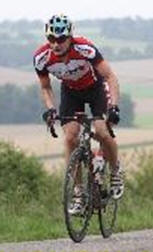 In the article above I've
mentioned other factors that need to be considered when looking at all
these stats. Well here they are.
In the article above I've
mentioned other factors that need to be considered when looking at all
these stats. Well here they are.
Altitude, and the availability of oxygen to power the muscles makes a significant contribution to your potential VAM. Climbing from sea level to a 1000 metres will give you a much higher VAM than climbing from 1600 meters to the summit of the 2650 metre Galibier.
Also the gradient itself has a significant VAM influence; the higher the gradient percentage, the higher the VAM values developed by the riders
Road based analysis has shown that 64 kg rider, producing a constant 300 watts gave the following results:
| ▼ |
5% |
= | 1180 | VAM meters hour | |||
| ▼ |
6% |
= | 1215 | ||||
| ▼ |
7% |
= | 1250 | ||||
| ▼ |
8% |
= | 1290 | ||||
| ▼ |
9% |
= | 1340 | ||||
| ▼ |
10% |
= | 1400 | ||||
| ▼ |
11% |
= | 1475 | ||||
| ▼ |
12% |
= | 1565 | ||||
| ▼ |
13% |
= | 1665 |
Dropping the kilo in weight we referred to earlier would increase your VAM by 25 m/h.
The Message
There you have it. We now have a metric that we use as
a comparison between ourselves and the pros. This article wont
make you a better climber, you have to go out and climb for that to
happen, but it can give you an extra dimension to the events you see
unfolding on the TV or as you stand on the side of a mountain pass when
the gods of the road are heading towards the heavens.
Be good, keep climbing and drop a kilo; it's easier than trying to gain 10 watts and cheaper than a new carbon frame!








